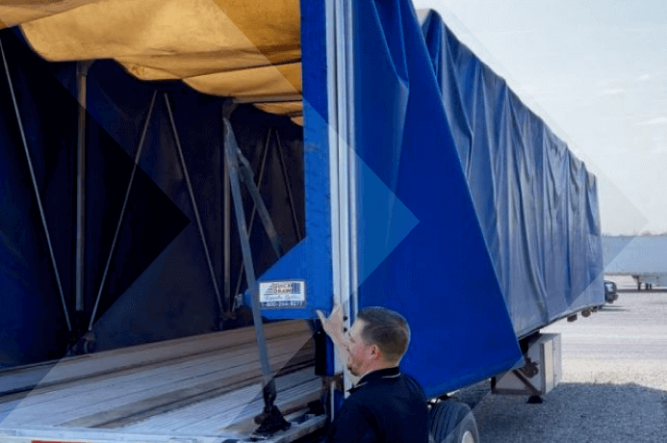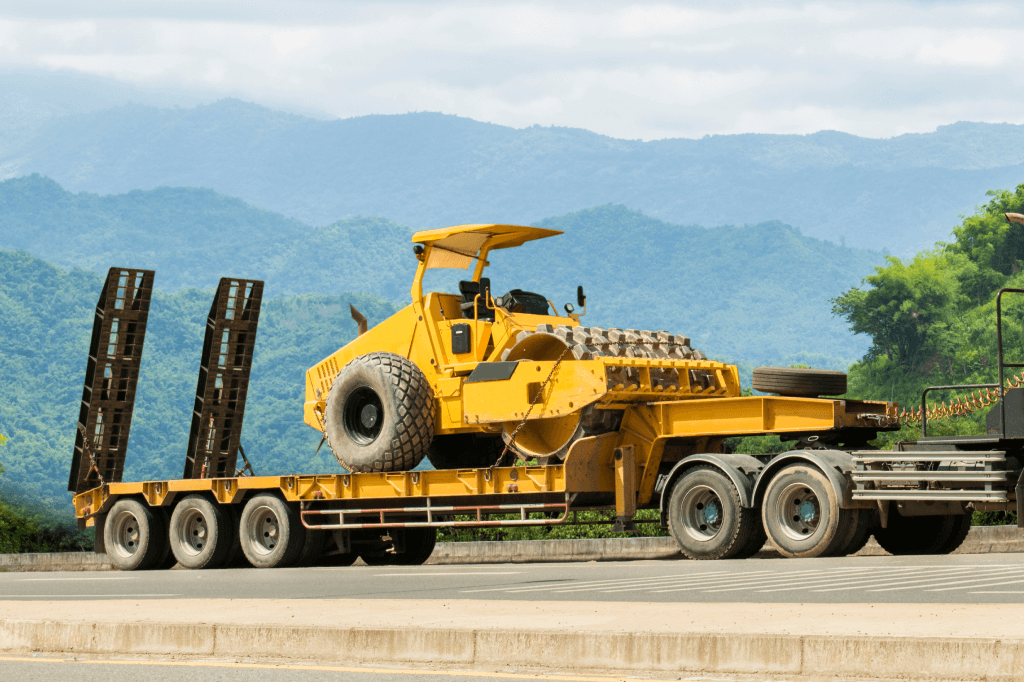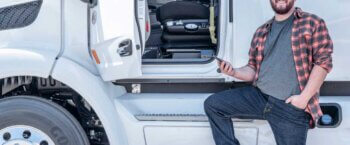Conestoga Trucking Trailers: Types, Pros and Cons

As a carrier, you have all kinds of options to optimize your trucking business. One way is by using the best equipment you can. Investing in quality equipment upfront helps you save money on maintenance, repairs, and upgrades in the long run. Conestoga trucking equipment is worth integrating into your business since this trailer type offers lots of versatility so that you can book more load types, expand your business operations and make more money.
What is a conestoga trailer?
A conestoga trailer is a flatbed frame trailer with a rolling tarp-on-frame system. It stands out from the crowd by being easy to use while offering additional load protection. This makes it ideal for keeping oversized loads out of harsh elements or for protecting specialized or delicate loads. Overall, these trailers are an excellent option to save you money and keep many types of loads safe.
Conestoga trailers vs. flatbeds vs. dry vans
What is a conestoga truck, and how does it differ from a flatbed or dry van? A conestoga trailer combines the benefits of the flatbed and dry van trailer. First, it has a flatbed trailer as a base for loading products. Once you’re done loading, bring the flexible tarp over the top of the load to keep it safe. This combines the protection you get from a dry van with a flatbed trailer’s ease of loading and functionality for various load sizes.
A flatbed trailer is one of the most common hauling options. Its simple design makes it popular for a wide variety of cargo. The hauling platform is entirely flat, so you can load from the top, rear, or sides. Because they don’t have walls, flatbed trailers are generally easier to load. That’s why you generally use flatbed trailers for heavier loads or moving containers around. They allow you to accept more load types, which means more job opportunities and more money.
A dry van trailer looks like a complete truck instead of being open-ended like the flatbed trailer. Dry vans are entirely enclosed boxes on the back of a freight hauler. They are designed to be highly versatile and transport a wide range of freight types. Typically, these trailers can haul a maximum of around 45,000 pounds. Because of its walled frame, it can haul many non-perishable goods, healthcare equipment, agriculture material, and even things like beverages.

3 types of conestoga trailers
Conestoga trucks have a few different tarping systems depending on what you’re hauling. It’s important to know what each of these trailers can do to pick the best option for your business.
1. Conestoga flatbed trailers
The conestoga flatbed trailer is the most common. It has a flatbed trailer with a roll-over tarp to protect it. They’re popular because they’re so versatile and easily unloaded. Conestoga flatbeds come in two size options, 48 and 53-foot versions. Though height and width can vary, usually they’re 8′ 4″ inches wide and 96″ high with weight capacities of 44,000 pounds.
2. Step-deck conestoga
The step-deck Conestoga trailer has two levels: one longer, lower deck and a shorter, higher deck. With these trailers, you can move things that require a higher height capacity than the 96 inches you get with a flatbed trailer. They come in 48′ and 53′ lengths. The height on the upper deck is still 96″, but the lower deck has a maximum height of 110″. They can handle up to 41,000 pounds.
3. Double drop conestoga
The double drop conestoga trailer is similar to the step-deck but the bottom portion is very low with a single step deck on the back and a double drop at the front, which means a level that goes up twice as far as a single step. It best suits oversize equipment that needs extra height or multiple loading docks on one trailer. Because of how low the deck is, you can even drive cargo onto the bottom trailer. The standard double drop Conestoga trailer is 48′. The front deck has a maximum height of 96″, the lower deck up to 139″, and the rear deck 114″. Its maximum weight capacity is 35,000 pounds.
Advantages of conestoga trailers
A conestoga trailer has quite a few advantages that set it apart from a typical flatbed trailer or a dry van. Keep these in mind when deciding whether a conestoga trailer will work well for your business.
Lower risk of damage
One of the most significant advantages of a conestoga trailer for the trucking industry is the flexible protection for the products you haul. The flexibility doesn’t restrict your options as much as the stationery walls of a dry van.
Sideloading and unloading
Because all angles are exposed, you can load and unload the conestoga truck in the most efficient way possible, saving you time.
Greater versatility
You can use the conestoga truck bed for a much larger variety of materials, keep them protected, and yet smoothly unload complicated products or machinery since you can easily take off the protective cover. You can also book a wider variety of jobs because of this protection.
Protection from the elements
A little wind and rain won’t hurt certain goods. But if you have delicate, painted, or easily rusted products, it’s nice to know that you’ll have extra cover to avoid moisture, dirt, and debris damage.
Faster delivery times
Keeping things protected and more secure allows your truck drivers to get to where they need to go more efficiently. This is because carriers don’t have to worry about driving slower to protect oversized loads or making more stops to check they are secure.
Disadvantages of conestoga trailers
While conestoga trailers are versatile and can provide more booking options, there are still downsides to consider before trucking companies invest in them.
Limited weight capacity
Conestoga trailers tend to have a relatively lower weight capacity. For example, the conestoga flatbed trailer has a weight limit of 44,000 pounds when most standard flatbeds can carry up to 48,000 pounds.
Limited dimensional capacity
Putting a cover over the top of your trailer limits the height of the load and doesn’t allow it to extend further over the flatbed. While it is more flexible than a dry van trailer, it is much less than a flatbed.
Higher costs
As with most things, having more flexibility and versatility comes at a price. Consider your typical loads and costs with one trailer type. Will you be able to book enough additional work to pay for increased functionality that a conestoga can provide?

Common conestoga trucking alternatives
Load boards can help you find spot market specialty freight that can satisfy your current carrier needs, making transportation altogether more cost-effective.
Step-deck
Step decks are well-suited to specific kinds of cargo, specifically tall cargo that would exceed the legal height limit if loaded on a typical flatbed. The Truckstop Step Deck Load Board helps you find good quality loads specific to step deck trailers.
Flatbed
As we covered earlier, flatbed trailers are the simplest, with a flat bottom and open sides for a wide variety of load types. If you are looking for better flatbed loads or jobs that are well-suited specifically to flatbed trailers, use the Truckstop flatbed load board to find the right one for you.
Low-boy
A low-boy trailer has a raised platform in the front, a very low bed, and a slightly raised back bed. These specialized trailers are best suited for oversized loads or those that are heavier than normal since they are very low to the ground. Find quality loads specific to a low-boy trailer with the Truckstop Low Boy Load Board.
Find and book high-paying conestoga loads
Load boards help you make more money by finding the best conestoga loads and brokers for your trucking business. Find all the specialty equipment you need on the Truckstop Load Board and keep your business successfully rolling forward. Sign up and get started today.
Get helpful content delivered to your inbox.
Sign up today.
Find high-quality loads fast, get higher rates on every haul, and access tools that make your job easier at every turn.






